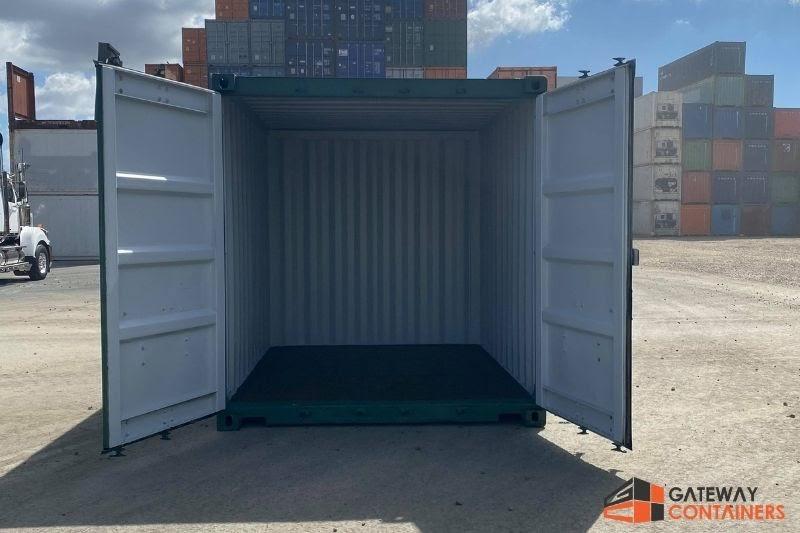Are you thinking of buying a container and want to understand the manufacturing process? Perhaps you’re just curious to know how a shipping container is made?
You can find out the answers in this article and watch a shipping container being constructed in Gateway’s video.
What are shipping containers made of?
Since the steel shipping container was introduced more than 60 years ago, it has totally changed international trade.
Standard 20ft containers and 40ft containers take up less space in ports and can be stacked on top of one another. While strong and secure refrigerated containers make it possible for large quantities of chilled or frozen goods to be transported domestically and internationally, across multiple modes of transport (e.g. ship, rail and truck).
A standard container is built to be extremely strong to successfully transport and protect the items it’s carrying. It is typically fabricated with Corten (weathered, corrosion-resistant) steel or SPA-H (superior atmospheric corrosion resistant) steel walls, a roof and doors, then welded together with steel castings reinforcing each of the eight corners.
The container doors are fitted with strong weatherproof seals and locking hardware to secure goods in a safe, secure and dry place. Flooring on a container is made from 28mm marine plywood that is secured across the steel base.
Since they are open to the elements on their sea journey, they need to be watertight, withstand rain, seawater, wind and many other extreme weather conditions. A shipping container is constructed to take a potential pounding while in transit.
Their strength and weatherproof capability are why they are now being used for many other applications – not just for shipping goods.
These days, used shipping containers are being repurposed as storage units, warehouses, portable offices, retail space, and even home construction. They are favoured for their affordable price and the strength, durability, and security that they offer the user.

The construction process: How a shipping container is made
1. Cutting, sanding and priming the steel sheets
Every shipping container starts as a big roll of steel. Step one involves unrolling the steel and cutting it into pieces. Following this, the steel pieces are bent into various profiles and container components, helping add to the finished product’s overall high construction quality and strength. Before welding anything into place, the steel is sandblasted and primed.
2. Strengthening the steel sheets
As strength is an essential element of all shipping containers, the steel sheets are then pressed into corrugated panels to increase their strength.
3. Welding the frame and wall panels
The process of welding the frame and wall panels together can now begin. For a shipping container to be classed as durable, all wall pieces must be welded into the container’s frame.
Some quick welds are made to form the basic rectangle, and then reinforcement is added by welding along the top of each of the corrugated steel walls. The most important part of this step is to ensure that the corners are perfectly aligned. Without this, the frame and even the whole process will fail.
4. Sealing the container
The Corten steel container doors are completed on their own as that process is more in-depth. The door panels come into the process assembled and ready to be put in place. These are attached to the container and then wall panels added. The corner posts are aligned and everything is welded together to increase the overall strength.
This waterproofs the container and ensures structural integrity remains throughout. Reinforcement is added to ensure any impact is spread around the frame, preventing damage. The container is now looking very close to being done. The roof is placed on with a crane and welded into place.
5. Final touches
Once a quality control and final sandblast occurs, the team uses machines to automate the painting of the base and topcoats.
Inside the shipping container, wooden flooring is fitted to give extra support and a durable storage base inside the container. Once the marine plywood flooring panels are placed inside the container, they are screwed into the cross-members.
This finalises the process of constructing a shipping container.
Customisations to fit your purpose
Standard containers aren’t insulated or air-conditioned, these are modifications that need to be completed by qualified technicians. At Gateway we can offer you this service, plus many more customisations, depending on your needs, including ventilation, locks, shelving, doors and windows.
The possibilities are endless, so if you’re interested in shipping containers for sale talk to our team about how we can customise a container for your requirements.
Alternatively, if you just require storage, we have a wide range of standard containers available, which may suit your storage needs. We provide a comprehensive service so you can enjoy the benefits of your container for years to come. We offer container delivery too!
Grab a free, no obligation quote today or get an instant live quote using our friendly chat bot below!

FAQs
What are the dimensions of 20ft shipping containers?
Exterior Dimensions:
- Length – 609.6 cm
- Width – 243.84 cm
- Height – 259.08 cm
Interior Dimensions:
- Length – 589.74 cm
- Width – 234.8 cm
- Height – 238.44 cm
Check out our container specifications chart for more information.
How much can a 20ft general purpose container hold?
A 20ft GP container can be loaded to a maximum weight of 28,190kgs or 33 cubic metres.
How much does a 20ft container weigh?
An empty 20ft container’s tare weight is 2,290kg.
How much does a 20ft container cost?
We recommend getting in touch with our friendly team to learn more about shipping container sizes, dimensions, and pricing.




